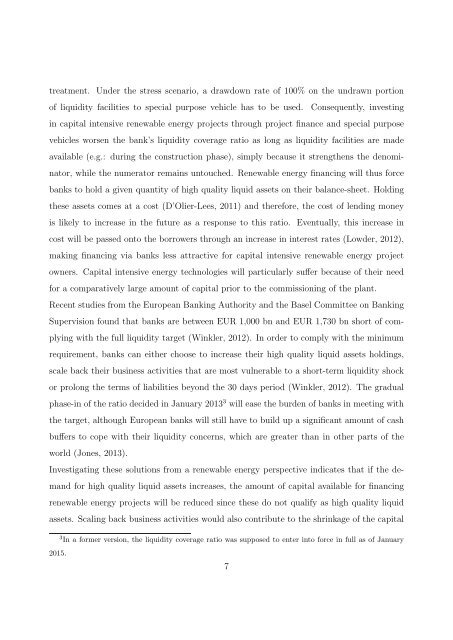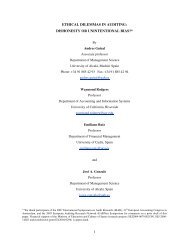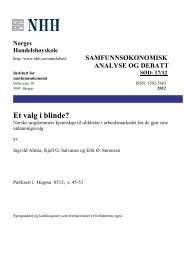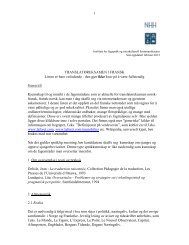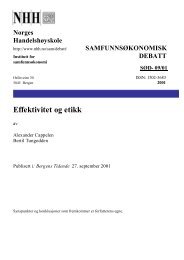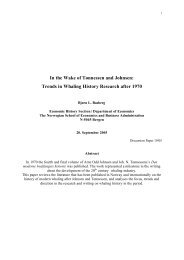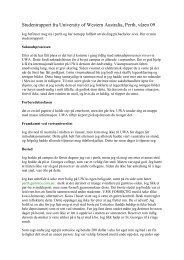The likely impact of Basel III on a bank's appetite for ... - NHH
The likely impact of Basel III on a bank's appetite for ... - NHH
The likely impact of Basel III on a bank's appetite for ... - NHH
Create successful ePaper yourself
Turn your PDF publications into a flip-book with our unique Google optimized e-Paper software.
treatment. Under the stress scenario, a drawdown rate <str<strong>on</strong>g>of</str<strong>on</strong>g> 100% <strong>on</strong> the undrawn porti<strong>on</strong><str<strong>on</strong>g>of</str<strong>on</strong>g> liquidity facilities to special purpose vehicle has to be used. C<strong>on</strong>sequently, investingin capital intensive renewable energy projects through project finance and special purposevehicles worsen the bank’s liquidity coverage ratio as l<strong>on</strong>g as liquidity facilities are madeavailable (e.g.: during the c<strong>on</strong>structi<strong>on</strong> phase), simply because it strengthens the denominator,while the numerator remains untouched. Renewable energy financing will thus <strong>for</strong>cebanks to hold a given quantity <str<strong>on</strong>g>of</str<strong>on</strong>g> high quality liquid assets <strong>on</strong> their balance-sheet. Holdingthese assets comes at a cost (D’Olier-Lees, 2011) and there<strong>for</strong>e, the cost <str<strong>on</strong>g>of</str<strong>on</strong>g> lending m<strong>on</strong>eyis <str<strong>on</strong>g>likely</str<strong>on</strong>g> to increase in the future as a resp<strong>on</strong>se to this ratio. Eventually, this increase incost will be passed <strong>on</strong>to the borrowers through an increase in interest rates (Lowder, 2012),making financing via banks less attractive <strong>for</strong> capital intensive renewable energy projectowners. Capital intensive energy technologies will particularly suffer because <str<strong>on</strong>g>of</str<strong>on</strong>g> their need<strong>for</strong> a comparatively large amount <str<strong>on</strong>g>of</str<strong>on</strong>g> capital prior to the commissi<strong>on</strong>ing <str<strong>on</strong>g>of</str<strong>on</strong>g> the plant.Recent studies from the European Banking Authority and the <str<strong>on</strong>g>Basel</str<strong>on</strong>g> Committee <strong>on</strong> BankingSupervisi<strong>on</strong> found that banks are between EUR 1,000 bn and EUR 1,730 bn short <str<strong>on</strong>g>of</str<strong>on</strong>g> complyingwith the full liquidity target (Winkler, 2012). In order to comply with the minimumrequirement, banks can either choose to increase their high quality liquid assets holdings,scale back their business activities that are most vulnerable to a short-term liquidity shockor prol<strong>on</strong>g the terms <str<strong>on</strong>g>of</str<strong>on</strong>g> liabilities bey<strong>on</strong>d the 30 days period (Winkler, 2012). <str<strong>on</strong>g>The</str<strong>on</strong>g> gradualphase-in <str<strong>on</strong>g>of</str<strong>on</strong>g> the ratio decided in January 2013 3 will ease the burden <str<strong>on</strong>g>of</str<strong>on</strong>g> banks in meeting withthe target, although European banks will still have to build up a significant amount <str<strong>on</strong>g>of</str<strong>on</strong>g> cashbuffers to cope with their liquidity c<strong>on</strong>cerns, which are greater than in other parts <str<strong>on</strong>g>of</str<strong>on</strong>g> theworld (J<strong>on</strong>es, 2013).Investigating these soluti<strong>on</strong>s from a renewable energy perspective indicates that if the demand<strong>for</strong> high quality liquid assets increases, the amount <str<strong>on</strong>g>of</str<strong>on</strong>g> capital available <strong>for</strong> financingrenewable energy projects will be reduced since these do not qualify as high quality liquidassets. Scaling back business activities would also c<strong>on</strong>tribute to the shrinkage <str<strong>on</strong>g>of</str<strong>on</strong>g> the capital3 In a <strong>for</strong>mer versi<strong>on</strong>, the liquidity coverage ratio was supposed to enter into <strong>for</strong>ce in full as <str<strong>on</strong>g>of</str<strong>on</strong>g> January2015.7


